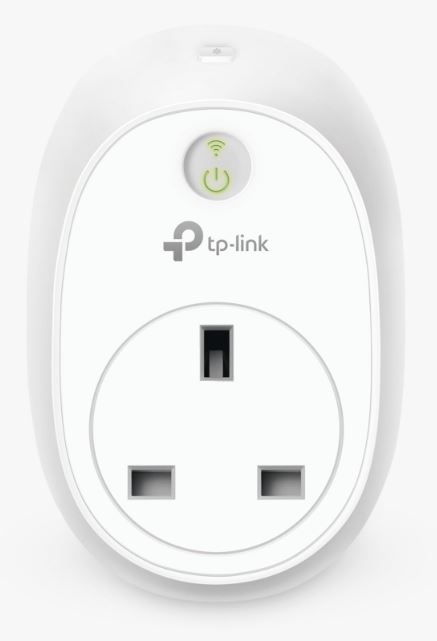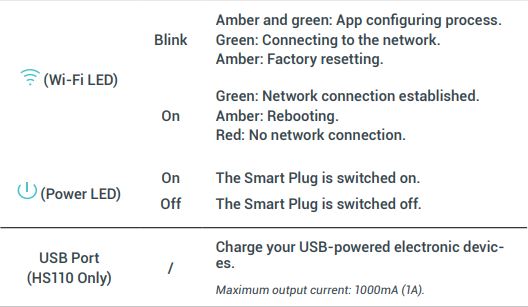TP-Link HS100 Wi-Fi Smart Plug

About TP-Link
TP-Link, a leading manufacturer of dependable networking hardware and accessories, was established in 1996 and is present in all facets of modern life. IDC, an analytical agency, has ranked the company as the top seller of Wi-Fi equipment for continuous 12 years*, with distribution to more than 170 nations and services to billions of people globally.
With a track record of stability, performance, and value, TP-Link has chosen a range of products to satisfy every user’s networking requirements. Now, as the connected lifestyle continues to develop, the business is growing now to meet and surpass demands for the future.
Introduction
Product Overview
What does This Product do?
The Wi-Fi Smart Plugs make it easy to control your lights or household electronic devices anywhere in the world with the TP-Link Kasa app on your smartphones or tablets.
Schedule and Away Mode
With Kasa’s Schedule and Away Mode, you can automate your lights or plugged-in appliances to turn on and off according to specific schedules, to simulate occupancy when you’re away from home. In addition, the countdown timer enhances safety by automatically switching off the running household appliances after a preset time.
Compatible with Amazon Echo
You can pair the Smart Plugs with Amazon Echo for voice control
Compatible with Android, iOS
The free Kasa app lets you run them from any Android (4.1 and higher) or iOS (iOS 8 and higher) smartphone.
Energy Conservation (for HS110 only)
You can efficiently conserve energy and save money while using the Smart Plugs to control your space heaters and fans. The Smart Plug tracks your device’s power consumption in real time and has weekly and monthly summaries.
Main Features
- Control devices connected to the Smart Plug wherever you have Internet using the free Kasa app on your smartphone.
- Schedule the Smart Plug to automatically power electronics on and off as needed, like setting lights to come on at dusk or turn off at sunrise.
- Analyze your plugged-in device’s real-time and historical power consumption. (for HS110 only)
- Turns your devices on and off at different times to give the appearance that someone is home.
- Amazon Echo (sold separately) lets you control devices connected to the Smart Plugs just by using your voice.
Panel Layout
The image may differ from the actual product due to different regional power specifications. Here we use the U.S. version as an example.

Supported Load Types
- Coffee Maker: 800 W
- Desk Lamp: 235.2 W
- LCD: 270 W
- Heater: 1500 W
- Humidifier: 260 W
- Iron: 1500 W
- Toaster: 850 W
- Tower Fan: 50 W
Quick Start
- Download Kasa for Mobile from the App Store or Google Play.

- Connect your mobile device to a 2.4GHz Wi-Fi network.

Note
The Smart Plug only supports 2.4GHz networks. - Launch Kasa and follow the app instructions to connect the Smart Plug to your network.
Troubleshooting
Frequently Asked Questions
- What devices can I control with the Smart Plug?
You can control lights, electronics, and small appliances such as humidifiers, air purifiers, portable heaters, and fans. - What should I do when I can’t control the connected device?
• Check that the connected device is switched to ON.
• Make sure your mobile device and the Smart Plug are on the same Wi-Fi network.
• Enable Remote Control to control the connected device from outside your home. - What should I do when the Wi-Fi LED is lit red?
A red LED light indicates no network connection.
• Check your network connectivity.
• Relocate the Smart Plug. Avoid placing the Smart Plug near potential sources of radio signal interference.
• Repeat the app configuring process.
• Factory reset the Smart Plug and try to add it again. - How do I pair the Smart Plug with Amazon Echo?
Visit www.tp-link.com/en/faq-944.html or within the Kasa Help section for pairing instructions.
Support
- Specifications can be found on the product page at www.tp-link.com
- Our Technical Support and troubleshooting information can be found at www.tp-link.com/support.
FCC Statement
This equipment has been tested and found to comply with the limits for a Class B digital device, pursuant to part 15 of the FCC Rules. These limits are designed to provide reasonable protection against harmful interference in a residential installation. This equipment generates, uses, and can radiate radio frequency energy and, if not installed and used in accordance with the instructions, may cause harmful interference to radio communications.
However, there is no guarantee that interference will not occur in a particular installation. If this equipment does cause harmful interference to radio or television reception, which can be determined by turning the equipment off and on, the user is encouraged to try to correct the interference by one or more of the following measures:
- Reorient or relocate the receiving antenna
- Increase the separation between the equipment and the receiver.
- Connect the equipment to an outlet on a circuit different from that to which the receiver is connected.
- Consult the dealer or an experienced radio/ TV technician for help.
This device complies with part 15 of the FCC Rules. Operation is subject to the following two conditions:
- This device may not cause harmful interference.
- This device must accept any interference received, including interference that may cause undesired operation.
Any changes or modifications not expressly approved by the party responsible for compliance could void the user’s authority to operate the equipment.
Note
The manufacturer is not responsible for any radio or TV interference caused by unauthorized modifications to this equipment. Such modifications could void the user’s authority to operate the equipment.
FCC RF Radiation Exposure Statement
This equipment complies with FCC RF radiation exposure limits set forth for an uncontrolled environment. This device and its antenna must not be co-located or operating in conjunction with any other antenna or transmitter.
“To comply with FCC RF exposure compliance requirements, this grant is applicable to only Mobile Configurations. The antennas used for this transmitter must be installed to provide a separation distance of at least 20 cm from all persons and must not be co-located or operating in conjunction with any other antenna or transmitter.”
This is a class B product. In a domestic environment, this product may cause radio interference, in which case the user may be required to take adequate measures.
OPERATING FREQUENCY(the maximum transmitted power)
2412MHz—2472MHz(20dBm) No restrictions exist in the use of radio frequencies or frequency bands in all EU member states
and EFTA countries.
EU declaration of conformity
TP-Link hereby declares that the device is in compliance with the essential requirements and other relevant provisions of directives 2014/53/EU, 2009/125/EC, and 2011/65/EU. The original EU Declaration of Conformity may be found at http://www.tplink.com/en/ce
RF Exposure Information
This device meets the EU requirements (2014/53/EU Article 3.1a) on the limitation of exposure of the general public to electromagnetic fields by way of health protection. The device complies with RF specifications when the device is used at 20 cm from your body.
Canadian Compliance Statement
This device complies with Industry Canada license-exempt RSSs. Operation is subject to the following two conditions:
- This device may not cause interference, and
- This device must accept any interference, including interference that may cause undesired operation of the device.
Radiation Exposure Statement
This equipment complies with IC radiation exposure limits set forth for an uncontrolled environment. This equipment should be installed and operated with a minimum distance of 20cm between the radiator & your body.
Industry Canada Statement
CAN ICES-3 (B)/NMB-3(B)
Safety Information
- Keep the device away from water, fire, humidity, or hot environments.
- Do not attempt to disassemble, repair, or modify the device.
- Do not use the device where wireless devices are not allowed.
- The socket outlet shall be installed near the equipment and shall be easily accessible.
- For passthrough devices, plug the power strips into the integrated electrical sockets of the devices, but devices of the same or another type not be stacked in normal use.
- The devices are not intended for use in locations where the temperature may be less than actual room conditions, such as unheated warehouses or garages.
Please read and follow the above safety information when operating the device. We cannot guarantee that no accidents or damage will occur due to improper use of the device. Please use this product with care and operate at your own risk.
Explanation of the symbols on the product label
FAQS About TP-Link HS100 Wi-Fi Smart Plug
What features does the TP Link Smart Plug have?
Remote Access – Use the free Kasa app on your smartphone to control devices connected to the Smart Plug from anywhere you have Internet access. Scheduling – You can program the Smart Plug to switch electronics on and off automatically as needed, such as configuring lights to turn on at twilight and off at sunrise.
What is the electricity consumption of a TP Link Smart Plug?
2 kilowatt hours or such
Can TP Link Smart Plug be used offline?
Yes, the gadget has locally installed copies of these functionalities. They will continue to operate even if the internet is gone.
What power capacity has a TP Link Smart Plug?
There is a maximum quantity of electricity that each smart plug can handle. For instance, the Kasa Smart Plug can support devices up to 1,500 watts while the WeMo Smart Plug and Amazon Smart Plug can tolerate up to 1,800 watts.
Are TP-Link smart plugs secure?
You could be attacked by someone utilizing TP Link or by someone finding out you use TP Link equipment. Every so often, CVEs are released for all kinds of hardware and applications. This also applies to TP Link. Businesses frequently experience breaches as well (sometimes without being aware of it).
Impact of smart plugs on WiFi?
The usual smart plug will consume very little WiFi bandwidth and shouldn’t significantly slow down WiFi.
What Wi-Fi networks does TP-Link support?
Yes
What advantages do smart plugs offer?
Your standby power consumption can be decreased and your usage patterns can be optimized by using smart plugs with voice assistants to help you save energy and money. For instance, you may check the status of your gadgets using voice assistants and turn them off if they are not in use.
When turned off, do smart plugs still draw power?
However, the smart plug itself continues to use a tiny amount of energy even when the appliances attached to it are off. For you to be able to operate them with your phone or another device, they must remain connected to your home’s Wi-Fi network.
Do smart plugs reduce energy use?
Smart plugs are an excellent method to conserve energy since even when they are left on, they don’t consume a lot of phantom power.
What is the smart plug’s range?
300 ft.
For more manuals by TP-Link, Visit Manualsdock
[embeddoc url=”https://manualsdock.com/wp-content/uploads/2023/08/TP-Link-HS100-Wi-Fi-Smart-Plug-User-Manual.pdf” download=”all”]


